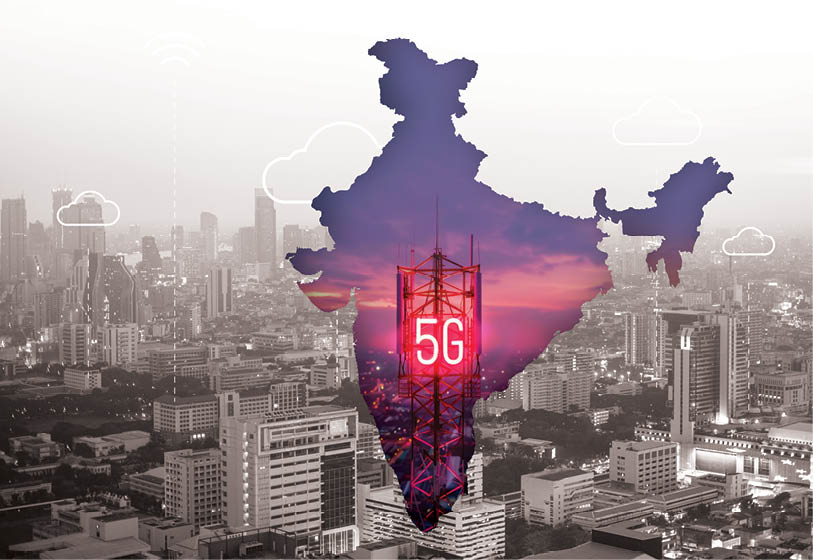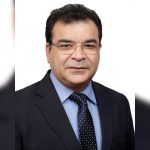Driven by increased broadband penetration, rising internet TV streaming services, and the overall growth of the telecommunications sector, the Indian optic fibre market is witnessing significant growth. The scale in which it is used underscores the technological reality that we stand on the brink of another revolution that will fundamentally alter the way we live, work, and relate to one another.

Landscape
Composed of very thin strands of extremely pure glass fibres, fibre optic cables essentially transmit information using light from lasers or LEDs that are modulated with data or used in some cases as a light source. Each strand can carry something like 25,000 telephone
calls, and an entire fibre-optic cable can easily carry several million calls. The origin goes to 1952, when UK-based physicist Narinder Singh Kapany invented the first actual fibre optical cable. Thirteen years later researchers Charles Kao and George Hockman discovered that attenuation of fibre optics was caused by impurities in manufacturing, and if the attenuation could be lowered sufficiently fibre optics could be used as a practical means of communication. The barrier was finally broken in 1970. In two decades, fibre optics became the dominant carrier of electronic information, forming the absolute backbone of the modern communications infrastructure. Today, they are used in internet installation, cable television, telecommunication, automobiles, medical, military, aerospace and lighting. The scale in which OFC is used underscores the technological reality that we stand on the brink of another revolution that will fundamentally alter the way we live, work, and relate to one another.
Growth Drivers
The global fibre optic cable market size is estimated at USD 12.83 billion in 2024, and is expected to reach USD 19.26 billion by 2029, growing at a CAGR of 8.46% during the forecast period (2024-2029), says Mordor Intelligence. Driven by increased broadband penetration, rising internet TV streaming services, and the overall growth of the telecommunications sector, the Indian optic fibre and accessories market is witnessing significant growth. An Actual Market Research report suggests that the size of the Indian market could cross USD 2.41 billion by 2028. Rapid expansion of 5G networks and the growing adoption of fibre-to-the-home (FTTH), in particular, are the major factors that will drive the robust growth in the coming years.
According to Vipul Nagpal, Founder and Managing Director, Orient Cables India, “A growing demand for high-speed internet and data transmission, coupled with increasing adoption of cloud computing, IoT, and smart technologies, along with environmental benefits such as lower energy consumption, are some of the factors which contribute to the attractiveness of the optical fibre cable segment, driving companies and innovators to explore opportunities in this field.” He notes that the need for a reliable, high-capacity and secure communication network has got a big push from the government, which has introduced a slew of schemes and initiatives to increase investments in digital infrastructure.
Mr. Sidharth Agrawal, Managing Director of Systematic Group concurs that India’s rapid growth and increasing demand for fast data transmission are driving the need for advanced communication networks. The MD shares the prediction that Optical Fibre Cables (OFC) are set to play a crucial role in building a robust and converged telecommunications network that meets the demands of wired broadband and future-ready 5G applications. He highlights how Systematic Group recognized the transformative potential of fibre optics in enabling faster and more reliable data transmission across various industries. “The rapid growth of digital communication and the increasing demand for high-speed internet access were key motivators for entering the optic fibre segment.” Mr. Agrawal highlights the recent tender of BSNL BharatNet Phase 3 project, valued at INR 1.4 lakh crore, which aims to extend high-speed internet connectivity to rural areas by upgrading existing infrastructure in 164,000 gram panchayats and connecting an additional 47,000 gram panchayats, covering a substantial portion of India’s rural landscape. “Our facility, which has already been approved from TSEC by BSNL, positions us perfectly to contribute to this monumental initiative. Additionally, our commitment to staying at the forefront of technological advancements drove us to invest in this sector, ensuring we contribute to the global shift towards more connected and smarter infrastructures,” he elaborates.
“OFCs are finding increasing applications in emerging sectors like data centers, which require high-speed and reliable connections to be enabled using optical fibre technology. The growth of smart cities and IoT also necessitates advanced fibre optic solutions for seamless connectivity and data transfer.”
Products Range
Mr. Harsh Pagay, Executive President – Optical Fibre & Optical Fibre Cable, HFCL shares that over the last two years of transformation, his company has evolved into a technology-driven enterprise with a strong focus on developing a comprehensive product portfolio. The company designs and produces a range of next-generation OFC solutions, including intermittent bonded ribbon (IBR) cables, FTTH cables, microduct cables and underground cables. These cables are offered in multiple variants with low-diameter and higher fibre densities, which are customized as per the consumer’s needs. HFCL’s cables portfolio finds application across a plethora of sectors like telecom, data centers, FTTH, defence and railways. Our high fibre count IBR cables are particularly well-suited for data centers, while our rugged armoured cables ensure high durability and performance in demanding environments, for industries such as railways and defence, says Mr. Pagay. Over the years, the company, he claims, has been able to maintain its leadership in the Indian OFC space, driven by our R&D efforts, particularly in micro cable designs. He says that the company’s ultra-compact 1728F IBR cable is designed to allow higher fibre counts in smaller diameter ducts, enabling cost-efficient deployment of networks and easy installation in congested areas. “Some of our cables, including IBR Microcable and 288-576F, have won various prestigious international awards like Cabling Innovators Award, LIGHTWAVE Award, and MERIT Award. HFCL has also received a patent for its ULW 96F cable, offering the company a first-mover advantage to capitalize on the growing demand,” he adds.
Sterlite Technologies Limited (STL) is another world’s leading optical and digital solutions provider. “Our optic fibre solutions cater to the requirements serving a wide range of applications. Our lower bend loss optical fibre is best suited for enabling high-network performance and significantly lower installation costs,” says Mr. Rahul Puri, Vice President and General Manager of Europe, the Middle East, India, and Africa & Asia Pacific at Sterlite Technologies Limited. STL offers a range of 250um and 200um bend insensitive single mode fibre and non-zero dispersion shifted single mode fibre (NZDSF) solutions suitable for 5G and FTTx applications. Mr. Puri maintains that they have really pushed the envelope in fibre optic technology with some exciting innovations that are shaping the future of connectivity. “Almost three decades back, we started with one plant in India, and today, we have 10 global production facilities, one of which is in the US. One of the greatest milestones in this journey has been setting up our own glass preform manufacturing – a rare feat in the global optical industry.”
Mr. Puri goes on to say that STL’s competitive edge lies in its ability to address the increasing data demands through innovative, fibre-deep networks and data centres, which are crucial for faster 5G and Fibre-to-the-Home (FTTH) adoption. What makes it unique is its wide product range, including patch cords, fibre termination boxes, joint closures and fibre management systems, all designed for seamless compatibility across various network bandwidths. These solutions cater to diverse applications, enabling network providers to easily build agile, flexible and high-quality networks. “STL’s optotec devices are particularly notable for their targeted approach, addressing the specific needs of networks and service providers. This makes it easier for companies to scale fibre deployment efficiently.”
Manufacturing a wide range of optical fibre cables at its plants in Goa and Maharashtra, Finolex Cables caters Mandatory Testing and Certification of Telecommunication Equipment (MTCTE)-certified products. According to the company’s President – Operations, Mr. Sunil Upmanyu, “Our product portfolio includes designs such as direct burial cables with corrugated steel tape armoring, suitable for telecom, highways, and utility sectors. We also produce wire armoured cables, featuring either steel or plastic tubes, designed for rugged applications, including use in challenging terrains like river crossings.” The company also specialises in developing and supplying IGFR (impregnated glass fibre) armoured cables, which are non-metallic and widely used by leading telecom operators. For urban areas, its unarmoured duct cables are preferred by telecom companies and contractors where cables are laid inside ducts. The company also produces high-capacity ribbon optical fibre cables in both armoured and unarmoured designs, with capacities of up to 1728 fibres, catering to data centres and the telecom sector. For regions with difficult terrain, such as hilly areas or river crossings, it manufactures aerial cables with various properties, including anti-tracking for power lines and ADSS cables with anti-bird bite features. “We also produce simplex and duplex cables for patch cords used in data centres, adhering to global standards. Our spiral armoured cables meet the needs of tower fibreisation, and our optical fibre cables are approved by all major telecom operators for the Fibre-to-the-Antenna (FTTA) applications. Furthermore, we manufacture and export microduct cables to various international markets,” says Mr. Upmanyu.
A new player in the segment offering a wide range is Systematic Group. Its offering includes single-mode and multi-mode fibres, each designed to meet specific performance criteria and application needs. “These include armoured/unnarmoured dust cable with unitube and multitube options, micro cables with unitube and multitube options, ADSS (All-Dielectric Self-Supporting) cable with single sheath and double sheath options, aerial cable with unitube and multitube options, and CATV cables,” shares Mr. Agrawal. According to him the cables are unique in their enhanced durability, flexibility, and optimized signal transmission capabilities, which are crucial for high-performance environments. They are engineered to excel in various applications, from telecommunications and broadband networks to industrial automation and data centres, ensuring reliable and high-speed connectivity.
Mr. Pramod Kumar Srivastava says West Coast Optilinks’ products find application in many sectors, such as telecommunications, utilities, data centres, smart cities, defence and other segments requiring high-speed data connectivity. Additional applications include healthcare, industrial automation, smart cities and intelligent transportation systems. “Looking ahead, we may explore emerging sectors that require a robust fibre infrastructure for high-volume data like renewable energy, smart homes, security and surveillance. Other potential areas of growth could be Internet of Things (IoT), AI and autonomous vehicles, all of which depend on reliable and high-speed data transmission provided by fibre optic technology,” the CEO adds.

The global fibre optic cable market size is estimated at USD 12.83 billion in 2024, and is expected to reach USD 19.26 billion by 2029, growing at a CAGR of 8.46% during the forecast period (2024-2029)
Enablers
The latest advancements in fibre optic technology are transforming the way we communicate and access information. “Researchers have achieved remarkable improvements in fibre optic transmission speeds, enabling faster data transfer rates. This means quicker downloads, seamless video streaming, and efficient data exchange,” says Mr. Nagpal.
Mr. Pankaj Priyadarshi says Rosendahl Nextrom is the only company in the world to offer a complete manufacturing value chain for optical fibre and cable production – from glass preforms to fibre drawing, testing, coloring, to the finished cable. He is the Global Director, Business Development – Fibre Optics, Managing Director – India, Rosendahl Nextrom. Rosendahl Nextrom’s machines are tailor-made in Europe, with all critical components produced in-house. The company is developing solutions for producing large optical fibre preforms using vacuum sintering to enhance cost efficiency and reduce dependency on helium, a volatile commodity. Additionally, it is continuously advancing fibre drawing and testing machines to boost productivity. Mr. Priyadarshi stresses that their latest innovations for the loose tube manufacturing process include a high-speed fibre launching system, a dual clenching system, reworked fibre cutting for high speeds and improved jelly-filling.
Over the past 30 years, STL has developed expertise across the entire optical fibre value chain, which it refers to as ‘glass to gigabit connectivity’. This involves the process of creating optical fibres, cables and optical connectivity, starting from the initial glass preform. It claims to be one of only six companies globally that produce our own glass preforms, which boast a remarkable purity of ~99.99 percent. The level of purity is so high that looking through these glass preforms would allow you to see the bottom of the ocean, says Mr. Puri. “These semiconductor-grade glass preforms are made using very high-purity (5N) chemicals. They are designed and manufactured in India at our glass plant in Aurangabad, Maharashtra. This facility is India’s first and only advanced clean room glass manufacturing plant.” Exceptional glass quality directly impacts the performance of optical fibres and high-quality fibres, in turn, impact the quality of cables. This integrated expertise ensures superior network performance.
On innovations, Mr. Puri says STL’s multicore multiverse fibre is a game-changer in terms of capacity. It can handle four times the fibre capacity compared to traditional designs. It’s perfect for high-demand environments, where bandwidth and speed are critical. Those dealing with tight spaces or complex installations rely on StellarTM fibre, the world’s first bend-resilient fibre. “It can perform exceptionally well even when bent around corners or in confined spaces. Plus, it’s fully backward compatible, so you don’t need to worry about upgrading your entire system,” he stresses. STL also focuses on reducing size without ‘compromising on performance’. It maintains that its 180-micron and 160-micron fibres are among the slimmest in the world. He says that they have three times more capacity than standard 250-micron fibres, making them ideal for applications needing less and top-notch performance.
Mr. Upmanyu asserts that Finolex Cables’s plants being certified with multiple ISO standards, including TL 9000 and ISO 9001, ensures that the cables are manufactured according to the highest global standards and practices. “We use advanced machinery sourced from top global suppliers to produce optical fibre and optical fibre cables that fully comply with customer specifications. For preform manufacturing, we have adopted the Vapour Axial Deposition (VAD) process, a technology commonly used by leading Japanese fibre optic companies.” Currently, Finolex Cables is the only company, Mr Upmanyu claims, in India using this state-of-the-art technology for mass production of single-mode low-loss bend-insensitive optical fibres.
HFCL has made significant R&D investments to continuously innovate and meet evolving industry demands while enhancing network infrastructure, Mr. Pagay says. With three R&D centers and a team of 305 dedicated professionals, it has focused on developing indigenous technology and its own IPR, while strengthening manufacturing capabilities with forward and backward integration. Over the years, this has enabled the company to create a robust supply chain with minimal reliance on external factors, positioning itself as a complete end-to-end service provider. “HFCL’s splitters are engineered to be space-efficient, best suited for compact network infrastructures. Our cabinet portfolio has helped telecom players and enterprises optimize network hardware and cable management systems.”
Watch: RR Kabel | Solar Cables | Solar Plant | Renewable Energy
Installation and After-Sales
Beyond supplying optical fibre cables, several companies manage the entire cable process, from warehousing to distribution. HFCL notes that it provides comprehensive, end-to-end solutions, ensuring customers receive full support at every stage for optimal performance. The company informs that its network solutions are designed to future-proof investments of customers, offering a lifespan of up to 25 years with consistent performance. “With the installation of a complete range of HFCL’s products, our customer servicing team also provides easy and convenient follow-up services. This approach not only maximizes efficiency, but also ensures durable and sustainable results. With our domain expertise and technological strengths, we have successfully deployed over 175,000 km of optical fibre cables across the length and breadth of our country,” Mr. Pagay elucidates.
Similarly, Finolex Cables claims to have launched a new vertical offering ‘Optical Fibre Cable installation services’ to provide our customers with end-to-end solutions, with operations having already started in a few states and are focusing on gaining strength and experience in this new venture. Mr Upmanyu states that the company’s commitment to quality has earned them the status of ‘a Key Deployment Partner’ with one of India’s leading telecom operators. We are also exploring the use of the latest technologies in fibre optic laying and deployment, similar to those used in developed countries, he adds.
Sustainability
The consensus across the industry is that sustainability is very crucial to all operations and should remain so, as the industry has a significant environmental impact. Mr. Nagpal maintains that Orient Cables India has implemented energy-efficient manufacturing processes, LED lighting and renewable energy sources, zero-waste-to-landfill policies and water-saving measures in manufacturing processes to reduce carbon footprint, packaging waste and energy consumption, as well as ensure scrap management. According to him, the company ensures responsible sourcing of raw materials, has obtained certifications like ISO 14001 (Environmental Management) and comply with environmental regulations.
Similarly, STL views it as integral to our purpose, not just as a compliance or corporate responsibility issue. Sustainability is embedded in everything the company does, from the projects it undertakes to the way it manages environmental impacts. It is actively working towards achieving net zero emissions by 2030. Mr. Puri asserts that STL has made significant strides by aligning with the Science-Based Targets Initiative (SBTi), which helps ensure that the targets are scientifically grounded. This is a part of the broader strategy, which also includes pioneering efforts like launching the world’s first third-party accredited eco-labelled methodology in the optical industry. In FY24 alone, their Indian and Italian plants achieved Zero Waste to Landfill (ZWL) and Zero Liquid Discharge (ZLD) certifications. “This means we’re effectively managing waste and recycling a substantial amount of water – about 162,000 cubic meters, significantly reducing our environmental footprint. Additionally, we’ve successfully diverted around 25,000 metric tonnes of waste from landfills.”
In resource conservation, STL has achieved replenishment of over 2.69 million cubic meters of water into local communities. Its afforestation efforts have seen the planting of approximately 290,000 trees in Maharastra’s Aurangabad. Through its RoboEdge program, the company says it is equipping young students in Maharashtra and Dadra and Nagar Haveli with advanced STEM skills, including robotics and AI. Additionally, our Jeewan Jyoti program supports women in over 100 villages in Maharashtra by providing them with skills and entrepreneurial opportunities,” Mr. Puri elucidates.
For Finolex, sustainability is not just a goal, but a guiding fundamental principle. It has a 5 MW solar power plant dedicated to captive consumption, allowing the company to produce optical fibres and optical fibre cables at its Urse plant in Maharashtra using green energy. This initiative, according to Mr. Upmanyu, also benefits customers by contributing to their sustainability goals. “All our plants are ISO 14001:2015 certified for environmental management systems. To reduce wood consumption, we supply OF cables in coils wherever possible. Our packing materials are made of polyethene bags used with a minimum thickness of more than 50 microns and are recyclable.”
HFCL is also shifting its product base towards greener products. One such example is the company’s Optibend portfolio, which, Mr. Pagay claims, has achieved a 64 percent reduction in the consumption of Polybutylene terephthalate (PBT), 30 percent less High Density Polyethylene (HDPE) consumption, and 5 percent less jelly consumption. Additionally, the company has replaced plastic packaging with cardboard and increased drum packaging by 40 percent, helping them improve packaging efficiency and reducing emissions during transportation. All raw materials the company uses in the manufacturing process comply with the Restriction of Hazardous Substances (RoHS) and the Registration, Evaluation, Authorisation and Restriction of Chemicals (REACH) regulations, Mr. Pagay stresses.
Challenges
In the face of prolonged geopolitical crises, nations raising trade tariffs and protectionism, the industry isn’t without its set of challenges. The European Commission Directorate General for Trade has levied provisional anti-dumping duty – ranging between 8.7% and 11.4% – on nearly a dozen Indian optical fibre cable makers, while exempting imports from HFCL Ltd and its subsidiary HTL Ltd. In June, a duty of 8.7% was levied on exports from Birla Cable Ltd, Universal Cables Ltd and Vindhya Telelinks Ltd to the European Union. As per the order, Sterlite Technologies and Sterlite Tech Cables Solutions Ltd will incur 11.4% duties on their exports while a 9.9% duty has been levied on Aberdare Technologies Private Ltd, Aksh Optifibre Ltd, Apar Industries Ltd, Polycab India Ltd, UM Cables Ltd, and ZTT India Private Ltd. All other exporters will incur a duty of 11.4%.
As a leading manufacturer and exporter of an extensive range of cables, Orient Cables India faces challenges, such as meeting the exponential growth in global bandwidth demand while maintaining quality of products and reducing production costs. While reducing production costs, it has to ensure consistent and high-quality of our products that meet stringent industry standards, regulations and certifications. Finolex Cables’ Mr. Upmanyu underlines global supply chain disruptions caused by geopolitical factors, including currency fluctuations and shifts in raw material prices, as significant challenges. One of the challenges HFCL has noted is dumping of low-quality OFCs from China, and the company sees the subsequent imposition of tariffs as a level-playing ground to protect players like them.
For Systematic Group, volatility in raw material prices, which impacts production costs, stands out as the major challenge. “In mature markets, the OFC sector is becoming increasingly saturated, with numerous players offering similar products. This intense competition leads to price wars, which can erode profit margins,” informs Mr. Agrawal. He also agrees that supply chain disruptions, particularly during global crises, also pose significant challenges in maintaining steady production and timely delivery.
India is a unique telecom market where post consolidation, there are only four telecom operators, says Mr. Srivastava. “Investment by telecom operators has been slow for the last few quarters and fibre deployment for mass roll out of the 5G network is yet to happen. Raw material price fluctuations, coupled with logistical challenges due to geo-political issues, are putting a lot of pressure on cost of products. While large buyers prefer to keep fixed prices for longer period/project durations, such uncertainty in input prices poses challenges to meet the cost and impacts margins significantly.”
Also Read: The Future of Optical Fibre Communication Network
Market Positioning
HFCL is a market leader in the Indian OFC market and a trusted partner of choice across key global markets, including the UK, Europe, the US, the Middle East and Africa. HFCL claims that it has maintained a leadership position with over 60 percent market share in the Indian OFC market. It is a key partner in key markets, including the UK, Europe, the US, the Middle East, and Africa. To meet rising demand, the company has expanded its optical fibre capacity from 12 million fibre kilometers (fkm) to 33 million fkm, and our optical fibre cable capacity from 25 million fkm to 30 million fkm. We are determined to capitalize on global opportunities and boost revenue from international operations, Mr. Pagay says. To achieve this, the company is actively developing new product portfolios that meet international standards and appointing employees, agents, and distributors in key markets.
Mr. Ashish D. Jain, Executive President & COO, Telecom Business, Polycab India Limited says they have continued expansion in OFC manufacturing capacity to meet the growing demands under BSNL’s BharatNet Phase III, SPV-run BharatNet Phase III and other upcoming projects. He goes on to say that the company continues to export OFCs and FRP rods, ARP rods and IGFR yarns in diverse customizations to meet the specific needs of its global clients.
Future and Market Outlook
Mr. Puri sees the Indian market with significant potential for increased fibre usage per person and the number of homes with access to fibre, driven by the growth of 5G technology. In the future, he expects substantial investments from both private and public sectors to boost the deployment of fibre for 5G towers, small cells and FTTH, to expand global fibre penetration. By fiscal year 2025, the National Broadband Mission aims to fibreise 70 percent of India’s base transceiver station (BTS) to support efficient 5G services. “Looking ahead to 2024-25, the market is expected to grow even more. Investments will continue to flow, new technologies will continue to emerge, and competition will increase, potentially leading to even better and more affordable products. Overall, this is an exciting time for the sector,” he adds.
Rosendahl Nextrom India’s Mr. Priyadarshi believes that despite current headwinds in the global telecom fibre landscape, the company is optimistic about the long-term potential of optical fibre deployment in India and globally. “There is a lot of interest in how the requirements will change with the large-scale adoption of AI. In particular, we are seeing high interest in specialty fibre and data centre solutions. Our focus for 2024-25 continues to be on addressing these new needs, while also further developing cost-effective manufacturing solutions for the optical fibre industry,” he stresses.
Programs like BharatNet should create a substantial market for optical fibre cables as they form the backbone of an expanded digital network, Mr. Srivastava notes. He underscores that innovations in optical technology in active space as well as advanced fibre materials are





